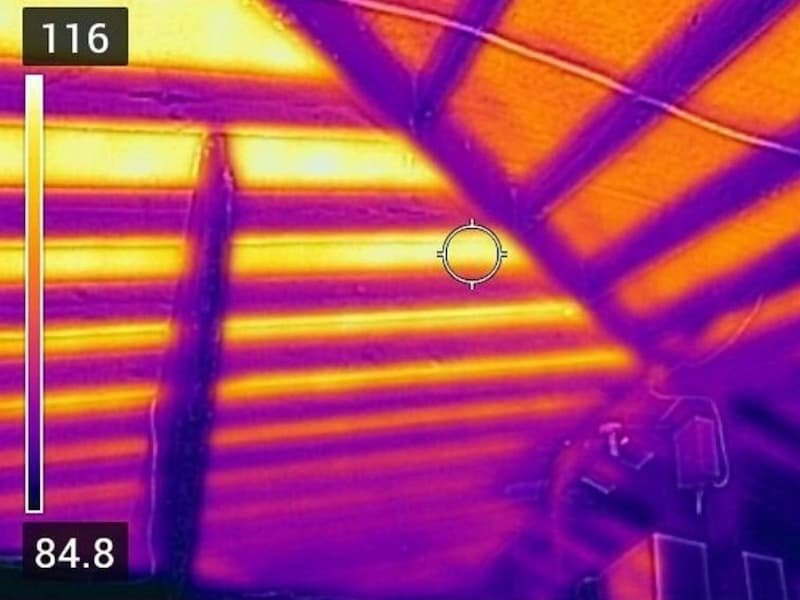Thermal imaging cameras have been widely adopted for surveying a building, machinery or electronics condition. These helpful tools enable professionals to conduct non-invasive analyses using thermal imaging. In addition, this vital data will dictate any maintenance that may be needed, thereby preventing disasters such as equipment shutdowns or building damage. Not all thermal cameras are the same, and each has a different specification that you need to be aware of to ensure you choose the best one for your needs.
What Resolution Do You Need?
The FLIR thermal imaging cameras supplied by us at Thermascan are straightforward devices that can provide the user with a staggering amount of IR (infrared) information for later analysis. These hand-held cameras will record digital images for later re-watching. The pixel resolution of your camera will be necessary for the amount of detail presented in your images.
When a thermal image is created, the camera has assigned a temperature reading to each pixel in the video, and with more pixels, more temperatures are accessible. This feature is helpful when using the live display on the back of the camera that will update your readings constantly. In addition, cameras come with unique specifications, including image resolution. For example, our FLIR E76 has an IR (infrared) resolution of 320 X 240 pixels, providing the user with 307,200 readings. This resolution can be suitable for home surveys, such as plumbing and electrics. However, for applications that demand more detailed images, you can choose one of our top-of-the-line thermal cameras, the FLIR T1020 providing 1024 x 768 IR resolution and a significantly more precise image thanks to its 786,432 pixels.
Temperature Ranges and NETD
Each thermal imaging camera for hire has a thermal range, sensitivity and NETD on their specification that dictates the range of temperatures they can detect; knowing these, you can be confident that your camera will provide accurate data on temperature.
NETD stands for noise equivalent temperature difference and is also known as thermal contrast. This anacronym states how effectively the thermal camera in question will read minor temperature differences in the thermal radiation. The unit of measurement used is usually a milli-Kelvin (mK). This is important because a camera with a high mK will create an image with more noise than a lower mK. Observing hotter areas is easier for the camera as more IR radiation is emitted, but cooler areas are more challenging to read. For example, a thermal camera reads interior walls with little temperature variations or emissivity changes during a building survey. Increasing sensitivity is better for discovering issues like poor insulation or moisture build-up.
What you need to remember is that the lower the thermal sensitivity number, the better the infrared readings. However, you should be careful of lower-cost manufacturers hiding poor sensitivity behind NETD at 50°C instead of the industry standard of 30°C.
Spectral Ranges Explained
The sensor on the thermal camera can detect a range of wavelengths. These comprise short, mid and longwave lengths suited to different applications to provide the best results.
Cameras suited to short wavelengths can detect infrared in the spectral range of 0.9 to 1.7 microns, a wavelength close to visible light. This kind of wavelength is used for portable imaging and art restoration. Midwave cameras can detect 2 to 5 microns and increase accuracy in readings. These are used for building surveys and machinery maintenance. Longwave lengths involve the 7 to 12 micron range, and cameras that can read them usually provide highly accurate readings for security and other applications.
Selecting a Thermal Palette
Similar to the wide variety of thermal cameras available, there are many different ways to interpret the images created. Whilst this may not seem specific to choosing your camera, what your surveying will be necessary to decide which camera to pick and knowing about the varied palettes will assist with this decision. All image palettes are digital images made up of brightly coloured pixels that quickly identify the different temperatures being observed. Cameras with a higher resolution will produce more dense images and more precise results. These coloured pixels are unique data points assigned to a heat value that you can analyse.
Different thermal palettes are better suited to specific surveys such as:
Rainbow HC has an easily recognisable temperature palette that uses the entire rainbow and works well for areas with less extreme temperature changes. It's commonly used for building surveys and checking insulation.
Iron uses a less varied palette that compares bright and dark colours in relation to the observed temperature. This is a valuable palette for mechanical or electrical surveys.
White hot palettes use a monochrome range where cooler objects are black and warmer in white with variations along the grey scale. It's commonly used for nighttime security.
Artic uses a limited colour palette of warm golden oranges and yellows against cooler blues. The darker shading of this palette helps pick out more minor temperature changes.
Black hot is the opposite of the previously mentioned hot white, with warmer objects displayed in darker monochrome. Also used for security, law enforcement commonly uses this palette along with nature documentaries.
High-Quality Thermal Imaging Cameras for Sale and Hire
At Thermascan, we specialise in providing the best range of high-end FLIR imaging cameras for sale or hire. So many businesses have improved their maintenance programs by including one of these effective thermal imaging cameras, contact us today and discover how our elite camera range can assist your business.









